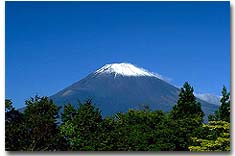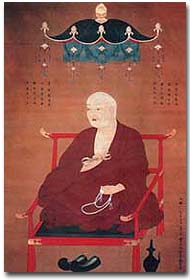10a. Japanese Religion and Spirituality

Its towering majesty and near-perfect symmetry make Mt. Fuji stand out — even in a heavily mountainous country like Japan. At 12,388 feet, the imposing mountain inspires spiritual awe, and many consider the lengthy hike up its slope a religious pilgrimage.
If a tree falls in the woods and no one is around to hear it, does it make a sound?
Since ancient times, Japanese philosophers have pondered basic, unanswerable questions about their natural environment. The early Japanese believed that the world around them was inhabited by gods and spirits, from streaks of mist obscuring jagged mountain peaks to water cascading over secluded waterfalls. Almost every aspect of Japan's stunning natural beauty evoked a sense of awe and wonder among its people.
The Way of the Gods
Ancient Japanese elevated this fascination with nature into what was later called Shinto, the Way of the Gods. This belief system that imbued every mountain, every stream, and even impressive trees with a spirit. These deities, known as kami, were considered cheerful and friendly to humans. If kept satisfied, they would watch over human affairs and refrain from causing natural disasters.
But the kami also would not hesitate to unleash their wrath if humans violated their cardinal rule of physical and spiritual cleanliness. To appease the kami, worshipers avoided defiling holy places by undergoing thorough ritual purification before passing beneath the torii, the gate leading into the sacred precinct of a Shinto shrine. Clean humans meant happy kami, and happy kami meant a peaceful realm.
Although its origins are obscure, Shinto helped forge national and political unity by emphasizing Japan's divine beginnings through myths and legends. For example, the Shinto creation myth tells of a pair of deities called Izanagi and Izanami who created the islands of Japan when droplets of water dripped down from Izanagi's spear. After the couple descended from the heavens to live on the islands, they had numerous divine offspring, including the sun goddess Amaterasu, the most important deity in Shinto.
Later generations of Japanese emperors claimed their divinity — and therefore their right to rule — by tracing their imperial lineage back to Amaterasu herself. As a direct descendent of the sun goddess, the emperor became a Living God who was to be worshiped along with his all-illuminating divine ancestor.
The Buddha Has Landed

Shinto was already well established as the national religion when Buddhism was transmitted from China (via Korea) to Japan in the 6th century C.E. As Buddhism gained popularity, it occasionally clashed with Shinto, but it did not displace the pre-existing religion. Rather, the two overlapped and complemented each other.
With its abundant scripture and rigid ethical code, Buddhism used precise terms to articulate concepts that Shinto had left vague. Whereas Shinto was generally life-affirming and flexible about human conduct (except in matters of purity), Buddhist philosophy provided a moral framework for the universe and addressed questions about death, reincarnation, and punishment for wrongdoing that Shinto failed to answer in detail.
The Buddhist teachings of impermanence (that nothing lasts forever) and emptiness (that nothing really has its own substance) became ingrained in Japanese thought and shaped subsequent philosophy, art, and literature.
One Hand Clapping
As in China, Buddhism developed in Japan with numerous sects vying for supremacy. Of the schools that did not die out and still exist today — such as Tendai, Shingon, Nichiren, and Zen — the Zen sect is probably the most distinctive.
The word "Zen" comes from the Sanskrit word dhyana (absorption), which reflects the attitude with which the practitioner should approach his or her pursuit of spiritual enlightenment. This goal is achieved through zazen (sitting Zen), a form of meditation in which the practitioner sits for hours on end in an attempt to free the mind from the fetters of worldly concerns.
A Zen master tries to help a novice break through the delusions and illusions of the mind to discover the true nature of things by employing kôans, seemingly paradoxical or nonsensical riddles intended to disrupt the mind's normal thinking process. "What is the sound of one hand clapping?" Anyone who has ever been asked this question has experienced the conundrum of a kôan.
A Chinese Flavor
Although Shinto and the various sects of Buddhism have dominated the hodgepodge that is Japanese spiritual life, other belief systems — mostly of Chinese origin — have influenced the way in which the Japanese have viewed the world.
Confucianism, the philosophy and religion based on the ethical and humanitarian teachings of Confucius, gained a foothold in Japan in the 7th century C.E. Its political theories and family values have persisted for centuries, and even became the official ideology of the state during the Tokugawa period (1600-1868).
Other significant belief systems have been Chinese astrology and feng-shui (earth study), as well as a host of other Chinese folk beliefs and practices.







